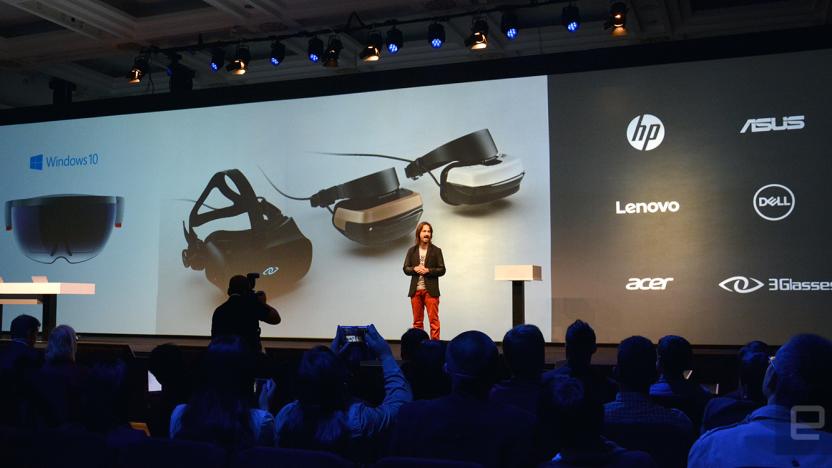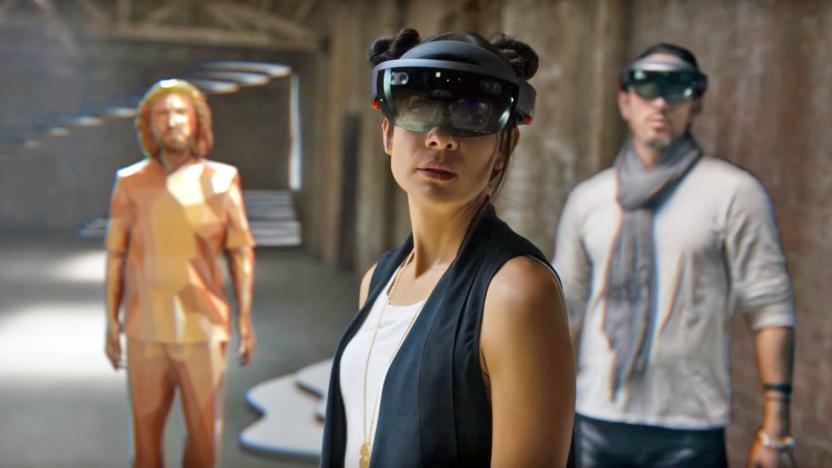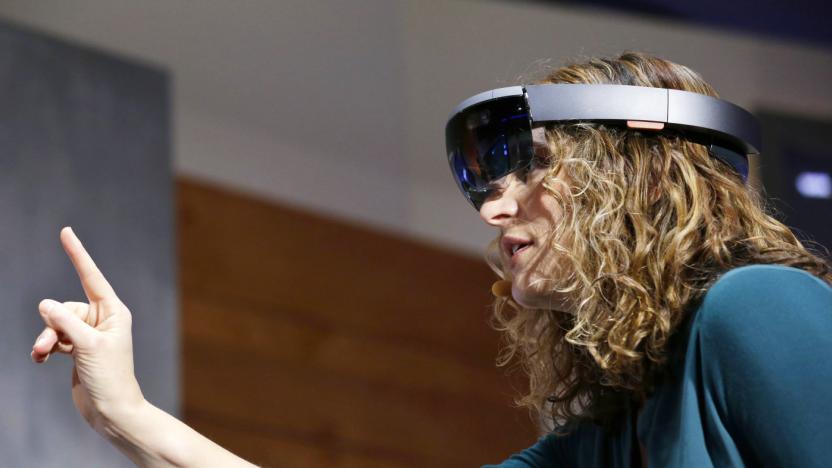windowsholographic
Latest

Microsoft posts HoloLens 2 teaser ahead of February 24th launch
You've had to wait a long, long time for news about HoloLens 2, but it's finally right around the bend. Device creator Alex Kipman has posted a teaser for the mixed reality headset that confirms its premiere just before Mobile World Congress on February 24th. The clip itself is cryptic, with vague allusions to processors and possibly carbon fiber (which could help reduce the weight). Not that you'd need to read the tea leaves to have an idea of what to expect -- there have already been a few clues.

Microsoft plans to bring mixed reality to the Xbox in 2018
Last year, Microsoft revealed it would open up its Windows Holographic Platform to other hardware manufacturers, and at CES, we got a sneak peek at a few different Windows VR headsets. At GDC this week, Microsoft revealed yet more plans for its mixed-reality platform. While its headsets are strictly for the PC right now, they will soon be coming to the Xbox -- as well as Microsoft's Project Scorpio console -- in 2018.

Lenovo's new VR headset is coming for less than $400
Let's face it: With the way things are going, you won't be able to dodge virtual reality forever. That's exactly why Lenovo has been working on a relatively inexpensive VR headset for Windows machines, and we got the chance to strap one on and take it for a spin. Before we go any further, though, let us answer the question you're surely asking: No, there's no word yet as to when the headset will ship (aside from "later this year"). That said, Lenovo has said the device will cost less than $400 when it goes on sale.

Microsoft has big plans for VR and AR in 2017
Ever since Microsoft announced earlier this year that it would be opening up its Windows Holographic platform to other device makers, the company has been an intriguing presence in the world of virtual and augmented reality (or "mixed reality," as it's fond of saying). After all, Microsoft could offer some healthy competition to the likes of Oculus and HTC, which launched their own VR headsets and platforms this year. Today at the WinHEC conference in Shenzen, the company is finally giving us a clearer sense of how it plans to bring mixed reality to more consumers.

Microsoft hints at what you'll need to run Windows 10 VR headsets
There's still much we don't know about Microsoft's plan to deliver virtual reality in Windows 10. At this point, we've heard it'll start with $299 headsets from a variety of PC manufacturers, and support for the Windows Holographic VR platform will arrive in in the Windows 10 Creators Update next year. There's plenty left up in the air beyond that (we'll likely hear more during an event next month). For now, we've got a sense of minimum PC requirements to run VR experiences, The Verge reports.

Microsoft has just what VR needs
In a move we should have seen coming from a mile away, Microsoft announced that it will be opening up the Windows Holographic platform, which powers HoloLens, to other companies. Those partners will be able to build AR headsets like HoloLens, full-fledged VR headsets like the HTC Vive, as well as components powering those devices. It's similar to Microsoft's original approach to PCs with Windows -- build the operating system and let others go wild with hardware -- as well as its push for new form-factors with the Surface. With the VR market still feeling like the Wild West, a bit of stability from Microsoft could be a huge help.

Microsoft releases first update for Windows Holographic
It's taken a long time to get real Windows 10 applications up and running on Hololens. The headset finally shipped to developers last March, and now the Windows Holographic dev kit has received its first update, adding several features like multitasking and the ability to rotate 3D models. These are the kind of interaction options that are important to the platform's survival.

HoloLens TED Talk shows what augmented reality can do
If you think you have a sense of what Microsoft's HoloLens headset can do, you're in for a pleasant surprise. The company's Alex Kipman recently presented a TED Talk on HoloLens that included multiple fresh demos illustrating Kipman's vision of an augmented reality future. He showed off virtual caves and forests, and a space where you could watch TV at one moment and talk to family in the next. The highlight, however, comes near the end: Kipman talks to an avatar of NASA's Jeffrey Norris standing on a recreation of Mars. Suddenly, Star Wars' holograms aren't so far-fetched.

Microsoft shows how you tell stories with HoloLens
When Microsoft started taking pre-orders for its HoloLens developer headset, it teased a digital storytelling app named Actiongram. But what is it, exactly, and how does it work? The folks in Redmond are finally ready to explain. In a detailed blog post, Microsoft has revealed that Actiongram is all about letting you create short, effects-laden mixed-reality videos without having to know a thing about 3D graphics. You just have to pick characters and props, place them in the world, and tell your tale. It's not particularly elaborate, but it shows how augmented reality apps can simplify this kind of creativity -- a video that would take days of compositing work could be wrapped up in an afternoon.

HoloLens' official PC app streams live video from your headset
You know that Microsoft's HoloLens will do a fair amount on its own, but what can it do in harmony with your PC? Quite a bit, actually. Fans have noticed that Hololens' official companion app for Windows 10 lets you download media, remotely launch apps and even watch a live stream from the augmented reality headset. The app is free to grab if you're curious, although it clearly won't be very useful unless you're willing to plunk down $3,000 for the developer headset -- think of this more as a peek at what you'll get when the eventual mainstream model hits shelves.

Microsoft HoloLens can talk to just about any device
As much as Microsoft has been willing to show of HoloLens, it has been surprisingly shy on some basic details. What devices work with the augmented reality headset? How long can you use it? How immersive will it really be? Thankfully, you just got answers to a few of those questions through a Microsoft evangelist's presentation at an Israeli event. To start, he notes that any Bluetooth- or WiFi-based device can talk to it, and it'll run any universal Windows 10 app. And yes, you can link multiple headsets for a shared experience, even over the internet.

Microsoft wants to make your dream HoloLens app
Think you have a really good idea for a HoloLens app? Microsoft might just help you build it. The tech giant has launched a Share Your Idea challenge that asks developers to submit their holographic app concepts by January 11th. It'll put the three most "viable" (that is, both good and realistic) ideas to a vote on Twitter, and will build the winner itself. You'll still have to devote some time to the app afterwards if you're successful -- you'll sit in for code reviews and Q&A sessions -- but this should be much easier than writing augmented reality software from scratch.

Microsoft shows off Windows Holographic running Windows 10 apps
When Microsoft debuted its Windows Holographic software and HoloLens headset a few months back, Windows 10 apps were mentioned as a possibility. Well, at Build 2015 today, the folks in Redmond offered a look at Windows 10 Universal apps in holographic action. During the onstage demo, apps could be placed on walls or set to float in space, and resized based on the user's needs -- something we'd only seen in videos up to this point. Of course, this means that users in different locations can collaborate on 3D models without having to be in the same room. Any Windows 10 app can be used as a hologram with the headset, so getting work done at a place other than your desk will soon be a possibility.

Microsoft isn't saying much about what's inside HoloLens
Without a doubt, the biggest surprise from today's Windows 10 keynote at Microsoft's Redmond campus was the outfit unveiling its HoloLens headset. Dubbed as the "first fully untethered, holographic computer" the device and its capabilities looked pretty neat -- if a little fantastical -- onstage when Alex Kipman showed it off. But for all his talk about breaking down the walls between technology and people, there are a surprising amount of them around exactly what the device is packing under the hood. We asked every person at the event that we could (developers, public relations folks, engineers) about the specs of the dev kit we tried, and were shot down at every turn. No one would give a single, concrete detail. So let's break down what was said during the stage demo (embedded below) and what Microsoft has released via the HoloLens website instead, shall we?

Here's the biggest news from Microsoft's Windows 10 event
Microsoft hinted that its January Windows 10 event would have a lot to offer, and boy was it right. The Redmond crew unveiled not just a ton of software features for desktops and mobile devices, but also new hardware that pushes the limits of what you thought computers could do. Overwhelmed? Don't be -- we've rounded up the biggest news from the event in the gallery below, so you'll know just what to expect when the new Windows is ready for prime time.

The design of Windows 10: a consistent look across all devices
We knew that Microsoft was planning to tuck that Modern UI inside the resurrected Start Menu for Windows 10, and today, the company provided more details on the next installment's aesthetics. When the update arrives, there will be a version that's designed specifically for devices that are smaller than eight inches in size. This means that the look and feel of the desktop and larger tablets will carry over, and universal apps will allow for seamless transitions from mobile to office sessions. Apps like PowerPoint and Word carry a similar look in mobile versions, and features, like a list of recently opened files, sync across phones, slates and desktop machines. The goal here is an easy-to-use cross-device experience that's accessible anywhere, and consistent aesthetics will certainly help.

Microsoft's HoloLens headset is a holographic display for Windows 10
Microsoft is building support for holographic displays into Windows 10, so it only makes sense that the company would make one of those displays, wouldn't it? Meet HoloLens, an official headset with see-through lenses that merges digital content with the physical. It includes spatial sound so that you can hear things happening behind you in the virtual world, and it even has a dedicated Holographic Processing Unit (HPU) to make sure everything works smoothly. The company is shy about just when it'll start selling HoloLens, but it should be available "in the Windows 10 time frame."

HoloLens is Microsoft's take on augmented reality
Microsoft's "dreaming beyond virtual worlds." Meaning, it's looking into holograms for, well, Windows Holographic. It looks an awful lot like an extension of the RoomAlive tech we've seen previously, but it isn't limited to gaming. According to Redmond's Alex Kipman, Holographic applications are Windows 10 universal apps so developers will be able to release them across a wide range of devices. The platform works in concert with the newly unveiled HoloLens headset that allows interaction between the physical and digital worlds. The outfit showed this all off with a live demo of an app dubbed HoloStudio wherein an employee built a quadrocopter onstage by pointing her finger and issuing voice commands like "mirror" and "copy." It all seemed pretty natural, actually. Kipman likened it to "print preview for 3D printing" and then pulled a 3D-printed version of the UFO-like quadrocopter seemingly out of his back pocket to show that it's more than just a concept -- it's a reality.






